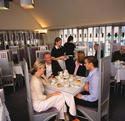 Glasgow's grimy greatness finally collapsed in this period and the economy began to shift rapidly towards a typical post-industrial structure dominated by services. This also meant a shift in the definition of work for many Glaswegians away from blue collar, male-dominated heavy industry towards more white collar, part-time work, often performed by women.
Glasgow's grimy greatness finally collapsed in this period and the economy began to shift rapidly towards a typical post-industrial structure dominated by services. This also meant a shift in the definition of work for many Glaswegians away from blue collar, male-dominated heavy industry towards more white collar, part-time work, often performed by women.
 In the city itself, the most remarkable changes were to be found from the early 1980s onwards. Argyle, Buchanan, and Sauchiehall Streets kept their places at the centre of retailing, but these were joined by the architectural wonders of the St. Enoch Centre, Princes Square and the Buchanan Galleries as the shopping experience moved resolutely upmarket. Nothing symbolised the shift in the city's priorities more than the glass and steel Parkhead Forge shopping centre on the site of Beardmore's engineering works.
In the city itself, the most remarkable changes were to be found from the early 1980s onwards. Argyle, Buchanan, and Sauchiehall Streets kept their places at the centre of retailing, but these were joined by the architectural wonders of the St. Enoch Centre, Princes Square and the Buchanan Galleries as the shopping experience moved resolutely upmarket. Nothing symbolised the shift in the city's priorities more than the glass and steel Parkhead Forge shopping centre on the site of Beardmore's engineering works.
 Tourism also came to Glasgow in the 1980s: the Glasgow International Garden Festival of 1988 was followed by the accolade of European City of Culture in 1990. The idea that, in 2000, Glasgow would be European City of architecture and in 2003 the European City of Sport, would have seemed fanciful forty years earlier. But these represented a new, more confident and outward looking city. With tourism came hotels and, especially in the 1990s, restaurants. By 2001, 6.4 per cent of all workers in the city were in the hotel and restaurants sector. In the same year, almost 15 per cent were employed in the wholesale and retail industries and 13 per cent in business services. This last begins to capture the rise of the call centre industry: cheap labour undertaking routine and low-skill activities were often the hallmark of service industries as they had been, in earlier days, of manufacturing.
Tourism also came to Glasgow in the 1980s: the Glasgow International Garden Festival of 1988 was followed by the accolade of European City of Culture in 1990. The idea that, in 2000, Glasgow would be European City of architecture and in 2003 the European City of Sport, would have seemed fanciful forty years earlier. But these represented a new, more confident and outward looking city. With tourism came hotels and, especially in the 1990s, restaurants. By 2001, 6.4 per cent of all workers in the city were in the hotel and restaurants sector. In the same year, almost 15 per cent were employed in the wholesale and retail industries and 13 per cent in business services. This last begins to capture the rise of the call centre industry: cheap labour undertaking routine and low-skill activities were often the hallmark of service industries as they had been, in earlier days, of manufacturing.